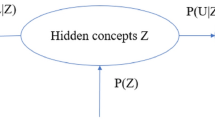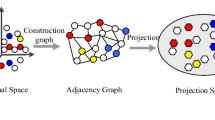Abstract
Machine learning algorithms play a critical role in electroencephalograpy (EEG)-based brain-computer interface (BCI) systems. However, collecting labeled samples for classifier training and calibration is still difficult and time-consuming, especially for patients. As a promising alternative way to address the problem, semi-supervised learning has attracted much attention by exploiting both labeled and unlabeled samples in the training process. Nowadays, semi-supervised extreme learning machine (SS-ELM) is widely used in EEG classification due to its fast training speed and good generalization performance. However, the classification performance of SS-ELM largely depends on the quality of sample graph. The graphs of most semi-supervised algorithms are constructed by the similarity between labeled and unlabeled data called manifold graph. The more similar the structural information between samples, the greater probability they belong to the same class. In this paper, the label-consistency graph (LCG) and sample-similarity graph (SSG) are combined to constrain the model output. When the SSG is not accurate enough, the weight of LCG needs to be increased, and vice versa. The weight ratio of two graphs is optimized to obtain an optimal adjacency graph, and finally the best output weight vector is achieved. To verify the effectiveness of the proposed algorithm, it was validated and compared with several existing methods on two real datasets: BCI Competition IV Dataset 2a and BCI Competition III Dataset 4a. Experimental results show that our algorithm has achieved the promising results, especially when the number of labeled samples is small.





Similar content being viewed by others
References
Brunner C, Birbaumer N, Blankertz B et al (2015) BNCI Horizon 2020: towards a roadmap for the BCI community. Brain-Comput Interfaces 2(1):1–10
Lotte F, Bougrain L, Cichocki A, Clerc M, Congedo M, Rakotomamonjy A et al (2018) A review of classification algorithms for EEG-based brain–computer interfaces: a 10 year update. J Neural Eng 15(3):031005
Tu WT, Sun SL et al (2013) Semi-supervised feature extraction for EEG classification. Pattern Anal Appl 16(2):213–222
She Q, Gan H, Ma Y et al (2016) Scale-dependent signal identification in low-dimensional subspace: motor imagery task classification. Neural Plasticity. https://doi.org/10.1155/2016/7431012
Ma YL, Ding XH, She QS, Luo ZZ et al (2016) Classification of motor imagery EEG signals with support vector machines and particle swarm optimization. Comput Math Methods Med. https://doi.org/10.1155/2016/4941235
Li RH, Potter T, Huang WT, Zhang YC et al (2017) Enhancing performance of a hybrid EEG-FNIRS system using channel selection and early temporal features. Front Hum Neurosci 11:462
Liang NY, Saratchandran P, Huang GB et al (2006) Classification of mental tasks from EEG signals using extreme learning machine. Int J Neural Syst 16(01):29–38
Huang GB, Zhu QY, Siew CK et al (2006) Extreme learning machine: theory and applications. Neurocomputing 70(1):489–501
Huang GB, Zhou H, Ding X et al (2012) Extreme learning machine for regression and multiclass classification. IEEE Trans Syst Man Cybern Part B (Cybernetics) 42(2):513–529
Gu Z, Yu Z, Shen Z et al (2013) An online semi-supervised brain-computer interface. IEEE Trans Biomed Eng 60(9):2614–2623
Zhu X, Goldberg AB (2009) Introduction to semi-supervised learning. Synth Lect Artif Intell Mach Learn 3(1):130
Nicolas-Alonso LF, Corralejo R, Gomez-Pilar J et al (2015) Adaptive semi-supervised classification to reduce intersession non-stationarity in multiclass motor imagery-based brain-computer interfaces. Neurocomputing 159:186–196
Tian X, Gasso G, Canu S et al (2012) A multiple kernel framework for inductive semi-supervised SVM learning. Neurocomputing 90:46–58
Xu H, Plataniotis KN et al (2017) Affective states classification using EEG and semi-supervised deep learning approaches. IEEE International Workshop on Multimedia Signal Processing, 7813351
Culp M, Michailidis G et al (2008) Graph-based semi-supervised learning. IEEE Trans Pattern Anal Mach Intell 30(1):174–179
Liu W, Wang J, Chang SF et al (2012) Robust and scalable graph-based semisupervised learning. Proc IEEE 100(9):2624–2638
Peng Y, Wang S, Long X et al (2015) Discriminative graph regularized extreme learning machine and its application to face recognition. Neurocomputing 149:340–353
Chang YC et al (2018) Graph-based data augmentation approach for electroencephalogram analysis. Int J Multidiscip Res Stud 1(3):298–307
Guan G et al (2013) Joint Rayleigh coefficient maximization and graph based semi-supervised for the classification of motor imagery EEG. IEEE International Conference on Information and Automation, pp 379–383
Zhong JY, Xu L, Yao DZ et al (2009) Semi-supervised learning based on manifold in BCI. J Electron Sci Technol 7(1):22–26
Li YF, Wang SB, Zhou ZH et al (2016) Graph quality judgement: a large margin expedition. International joint conference on artificial intelligence AAAI Press, pp 9–15
Wang H, Wang SB, Li YF et al (2016) Instance selection method for improving graph-based semi-supervised learning. Proceedings of the 14th Pacific Rim international conference on artificial intelligence, pp 565–573
Yi Y, Qiao S, Zhou W et al (2018) Adaptive multiple graph regularized semi-supervised extreme learning machine. Soft Comput 22(11):3545–3562
Huang G, Song S, Gupta JND et al (2014) Semi-supervised and unsupervised extreme learning machines. IEEE Trans Cybern 44(12):2405–2417
Zhou Y, Liu B, Xia S et al (2015) Semi-supervised extreme learning machine with manifold and pairwise constraints regularization. Neurocomputing 149:180–186
She Q, Hu B, Gan H et al (2018) Safe semi-supervised extreme learning machine for EEG signal classification. IEEE Access 6:49399–49407
Melacci S, Belkin M et al (2011) Laplacian support vector machines trained in the primal. J Mach Learn Res 12(5):1149–1184
Gan H, Sang N, Huang R et al (2015) Manifold regularized semi-supervised gaussian mixture model. J Opt Soc Am A 32:566–575
Jebara T, Jun W, Shih-Fu C et al (2009) Graph construction and b-matching for semi-supervised learning. Proceedings of the 26th annual international conference on machine learning, pp 441–448
Gan H, Li Z, Wu W et al (2018) Safety-aware graph-based semi-supervised learning. Expert Syst Appl 107:243–254
Zhou YH, Zhou ZH et al (2016) Large margin distribution learning with cost interval and unlabeled data. IEEE Trans Knowl Data Eng 28:1749–1763
Chen X, Wang T (2017) Combining active learning and semi-supervised learning by using selective label spreading. IEEE international conference on data mining workshops, New Orleans, USA, 17448855
Nie F, Li J, Li X et al (2016) Parameter-free auto-weighted multiple graph learning: a framework for multiview clustering and semi-supervised classification. International joint conference on artificial intelligence AAAI Press, New York, USA, pp 1881–1887
Song J, Gao L et al (2016) Optimized graph learning using partial tags and multiple features for image and video annotation. IEEE Trans Image Process 25(11):4999–5011
Biggs N et al (1998) Spectral graph theory. Bull Lond Math Soc 30(2):196–223
Joachims T et al (1999) Transductive inference for text classification using support vector machines. Proceedings of the 16th international conference on machine learning, San Francisco, USA, 99: 200–209
Tangermann M, Muller KR, Aertsen A, Birbaumer N, Braun C, Brunner C et al (2012) Review of the BCI competition IV. Front Neurosci 6:55
Ang KK, Chin ZY, Wang CC, Guan CT, Zhang HH et al (2012) Filter bank common spatial pattern algorithm on BCI competition IV datasets 2a and 2b. Front Neurosci 6:39
Meng M, Zhu JQ, She QS, Ma YL et al (2016) Two-level feature extraction method for multi-class motor imagery EEG. Acta Automatica Sinica 42:1915–1922
Blankertz B, Klaus-Robert M, Krusienski DJ et al (2006) The BCI competition III: validating alternative approaches to actual BCI problems. IEEE Trans Neural Syst Rehabil Eng 14(2):153–159
Gan HT, Sang N, Huang R et al (2015) Manifold regularized semi-supervised gaussian mixture model. J Opt Soc Am A-Opt Image Sci Vis 32:566–575
Gan HT, Luo ZZ, Meng M, Ma YL, She QS et al (2016) A risk degree-based safe semi-supervised learning algorithm. Int J Mach Learn Cybern 7:85–94
Hamilton W L, Ying R, Leskovec J et al (2017) Inductive representation learning on large graphs. Proceedings of the 31th Conference on Neural Information Processing Systems, Long Beach, CA, USA, pp 1024–1034
Acknowledgements
This work was supported by National Natural Science Foundation of China under Grant Nos. 61871427 and 61971168, Key Research & Development Project of Zhejiang Province (2020C04009) and Graduate Education & Teaching Reform Project of Hangzhou Dianzi University (No. JXGG2019ZD001).
Author information
Authors and Affiliations
Corresponding author
Ethics declarations
Conflict of interests
The authors declare that there is no conflict of interests regarding the publication of this article.
Rights and permissions
About this article
Cite this article
She, Q., Zou, J., Meng, M. et al. Balanced Graph-based regularized semi-supervised extreme learning machine for EEG classification. Int. J. Mach. Learn. & Cyber. 12, 903–916 (2021). https://doi.org/10.1007/s13042-020-01209-0
Received:
Accepted:
Published:
Issue Date:
DOI: https://doi.org/10.1007/s13042-020-01209-0




